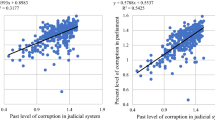Abstract
Recent empirical work shows that judicial dependence can explain high levels of corruption. This paper examines how the dependence of judiciaries influences corruption at different levels of the government in a model where the central government, low-level officials, and the judiciary are corrupt. In the model, the central government sells offices to low-level officials and demands ex-post payments enforced by the judiciary. Because an independent judiciary can rule against the central authority and accept bribes from stealing low-level officials, it reduces corruption at the higher level of government but promotes corruption at the lower level. Therefore, even if highly corrupt, an independent judiciary may reduce total corruption.
Similar content being viewed by others
References
Ades A, Di Tella R (1997) The new economics of corruption: a survey and some new results. Polit Stud 45: 496–515
Alesina A, Roshental H (1996) A theory of divided government. Econometrica 64: 1311–1341
Banerjee A (1995) Eliminating corruption. Mimeo, MIT, Massachusetts
Banerjee A (1996) Can anything be done about corruption. In: Quibria MG, Dowling JM (eds) Current issues in economic development: an Asian perspective. Oxford University Press, Oxford
Bardhan P (1997) Corruption and development: a review of issues. J Econ Lit 35: 1320–1346
Baye MR, Kovenock D, De Vries CG (1993) Rigging the lobbying process: an application of the all-pay auction. Am Econ Rev 83: 289–301
Becker GS, Stigler GL (1974) Law enforcement, malfeasance, and compensation of enforcers. J Legal Stud 3: 1–19
Bernheim DB, Whinston MD (1986) Menu auctions, resource allocation, and economic influence. Q J Econ 101: 1–31
Boylan RT (2000) An optimal auction perspective on lobbying. Soc Choice Welf 17: 55–68
Carmichael L (1985) Can unemployment be involuntary? Am Econ Rev 75: 1213–1214
Coolidge JG, Rose-Ackerman S (1997) High-level rent seeking and corruption in African regimes: theory and cases. World Bank Working Papers series: Governance, Corruption, Legal Reform, No: 1780. The World Bank, Washington
Djankov S, La Porta R, Lopez de Silanes F, Shleifer A (2002) The regulation of entry. Q J Econ 117(1): 1–37
Glaeser EL, Shleifer A (2002) Legal origins. Q J Econ 117: 1193–1229
Goel RK, Rich DP (1989) On the economic incentives for taking bribes. Public Choice 61: 269–275
Goel RK, Nelson MA (1998) Corruption and government size: a disaggregated analysis. Public Choice 97: 107–120
Goel RK, Nelson MA (2007) Are corrupt acts contagious? Evidence from the United States. J Policy Model 29: 839–850
Huther J, Shah A (2000) Anti-corruption policies and programs: a framework for evaluation. World Bank Policy Research Paper No: 2501, December
Huntington SP (1968) Political order in changing societies. Yale University Press, New Haven
Klitgaard R (1988) Controlling corruption. University of California Press, London
La Porta R, Lopez-de-Silanes F, Shleifer A, Vishny R (1999) The quality of government. J Law Econ 15: 222–279
La Porta R, Lopez-de-Silanes F, Pop-Eleches C, Shleifer A (2004) Judicial checks and balances. J Polit Econ 112: 445–470
Mookerjee D, Png IPL (1995) Corruptible supervisors and law enforcers: how should they be compensated? Econ J 105: 145–159
North DC, Weingast BR (1989) Constitutions and commitment: evolution of institutions governing public choice in 17th century England. J Econ Hist 49: 803–832
Olson M (2000) Power and prosperity, outgrowing communist and capitalist dictatorships. Basic Books, New York
Persson T, Roland G, Tabellini G (1997) Separations of powers and political accountability. Q J Econ 112: 1163–1202
Polinsky MA, Shavell S (2001) Corruption and optimal law enforcement. J Public Econ 81: 1–24
Priks M (2007) Judiciaries in corrupt cocieties. CESifo Working Paper, No: 2008
Reinikka R, Svensson J (2004) Local capture: evidence from a central government transfer program in Uganda. Q J Econ 119: 679–705
Reinikka R, Svensson J (2005) Fighting corruption to improve schooling: evidence from a newspaper campaign in Uganda. J Eur Econ Assoc 3: 259–267
Riordan W (1995) A series of very plain talks on very practical politics. Signet Classic, New York
Rose-Ackerman S (1978) Corruption: a study in political economy. Academic Press, New York
Shleifer A, Vishny R (1993) Corruption. Q J Econ 108: 599–617
Stephenson M (2001) Judicial independence: what it is, how it can be measured, why it occurs. Mimeo, The Worldbank, Washington
Svensson J (2005) Eight questions about corruption. J Econ Persp 19: 19–42
The Heritage Foundation, “Index of Freedom 2001”
Tullock G (1980) Efficient rent seeking. In: Buchanan JM, Tollison RD, Tullock G (eds) Toward a theory of the rent-seeking society. Texas University Press, Texas
Wade R (1982) The system of administrative and political corruption: canal irrigation in South India. J Dev Stud 18: 287–328
Wade R (1984) Irrigation reform in conditions of populist anarchy. J Dev Econ 14: 285–328
World Business Environment: (1997) Measuring conditions for business operation and growth. The World Bank, Washington
Author information
Authors and Affiliations
Corresponding author
Additional information
I wish to thank Philippe Aghion, Alberto Alesina, Fredrik Andersson, Stefano Della Vigna, Rafael Di Tella, Nicola Gennaioli, Edward Glaeser, Bengt Holmström, Sten Nyberg, Torsten Persson, Per Pettersson-Lidbom, Ilia Rainer, Jesper Roine, Andrei Shleifer, Stergios Skaperdas, David Strömberg, Jenny Säve-Söderbergh, Jean Tirole, Francesco Trebbi, Thierry Verdier, Hans Wijkander and seminar participants at Harvard University, Stockholm University, the Stockholm School of Economics, the Institute for Industrial Research in Stockholm, the University of Munich, NUI at Maynooth and the CEU Workshop in Budapest on Comparative Institutional Economics for their helpful comments.
Rights and permissions
About this article
Cite this article
Priks, M. Judiciaries in corrupt societies. Econ Gov 12, 75–88 (2011). https://doi.org/10.1007/s10101-010-0082-y
Received:
Accepted:
Published:
Issue Date:
DOI: https://doi.org/10.1007/s10101-010-0082-y




